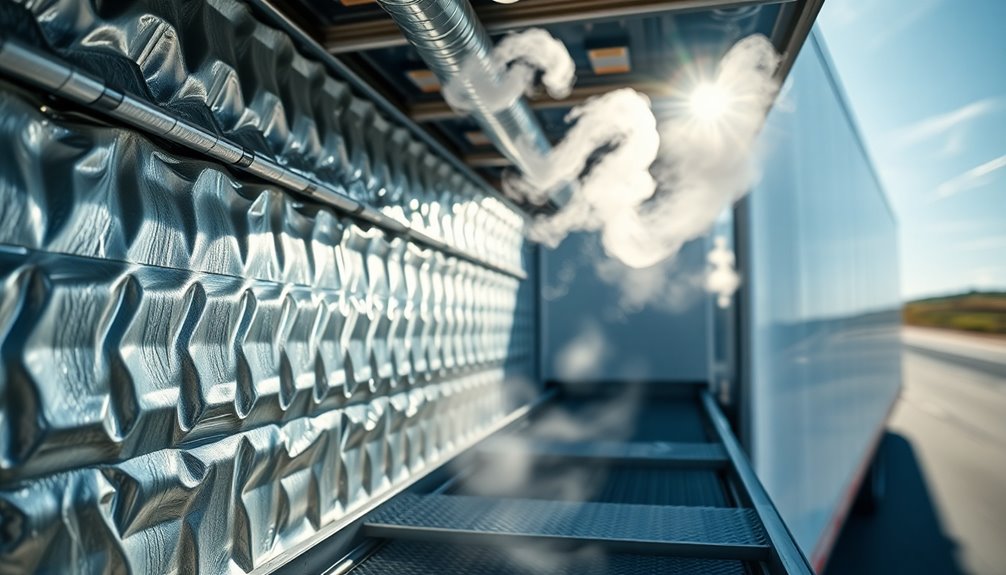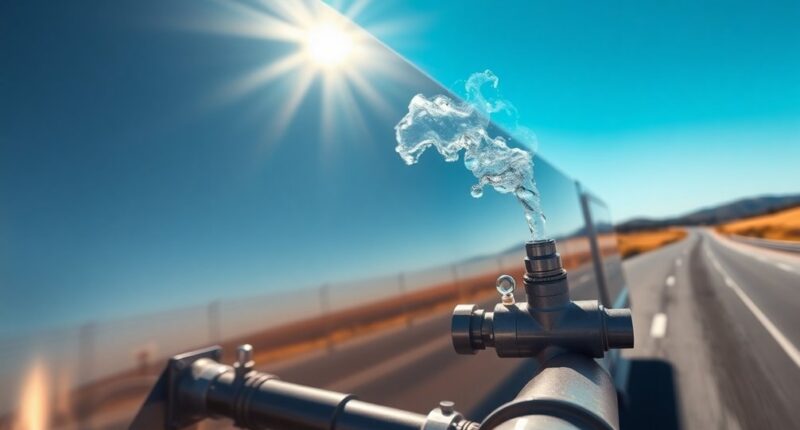The inner framework of liquid hydrogen (LH2) trailers directly influences boil-off gas (BOG) generation. If insulation fails or heat inleak occurs, the temperature inside rises, causing hydrogen to vaporize. This leads to increased pressure and potential safety risks. Efficient designs and advanced insulation materials help maintain low temperatures, minimizing BOG. You'll discover more about the role of these systems and innovations that enhance safety and efficiency in LH2 transport as you explore further.
Key Takeaways
- The insulation quality of the trailer's inner framework significantly influences heat inleak, directly affecting boil-off gas generation.
- Internal pressure management systems within the framework help control BOG but may inadvertently lead to gas formation if not adequately designed.
- The structural design must withstand low temperatures, as any material failure can result in increased heat transfer and BOG production.
- Reliquefaction systems integrated into the framework can mitigate BOG by converting it back to liquid hydrogen, enhancing overall efficiency.
- Advanced insulation materials used in the inner framework are crucial for minimizing heat inleak and ensuring consistent low temperatures to reduce BOG.

Liquid hydrogen (LH2) trailers play a crucial role in the transportation of this essential fuel, but their design and operation come with unique challenges. The trailers must maintain LH2 at extremely low temperatures, around -250°C. This requirement demands well-insulated containers to minimize heat inleak, a critical factor in preventing boil-off gas (BOG) generation. If heat seeps in, it warms the LH2, leading to pressure increases that can compromise both safety and efficiency.
Efficient insulation technology is fundamental to reducing heat transfer and minimizing BOG. The tanks are specially designed to withstand the extreme cold while managing the internal pressure that BOG creates. You'll find that some trailers even incorporate reliquefaction systems to convert BOG back into liquid hydrogen, effectively reducing losses. Effective management of boil-off gas (BOG) ensures safety and efficiency in hydrogen transport operations, which is essential for the sustainability of the supply chain.
Efficient insulation and advanced reliquefaction systems are vital for minimizing BOG and enhancing LH2 trailer operations.
Maintaining consistent low temperatures is vital; it directly impacts boil-off rates and thus the overall efficiency of the hydrogen supply chain.
Managing BOG isn't just about keeping the trailer functional; it's also about safety. Venting systems can release BOG to manage pressure, but this method isn't efficient because it results in hydrogen loss. More sophisticated strategies, like utilizing BOG as fuel in specific applications, can help reduce waste and enhance energy efficiency.
Advanced pressure management systems are also essential for controlling the internal environment of the trailer, ensuring safe operation while minimizing boil-off losses.
Innovations in technology are driving improvements in this area. Research into better insulation materials aims to cut down on heat inleak, while more efficient reliquefaction technologies seek to minimize energy consumption.
Additionally, advanced risk assessment tools, employing fuzzy logic, can optimize BOG management decisions by identifying the best times and locations for release. By embracing these advancements, you can help improve the overall safety and efficiency of LH2 trailer operations, paving the way for a more sustainable hydrogen supply chain.
Frequently Asked Questions
What Are the Safety Measures for Transporting LH2 Trailers?
When transporting LH2 trailers, you need to prioritize several safety measures.
Ensure your vehicle complies with relevant regulations and maintains structural integrity to prevent leaks. Use trained personnel for handling and transfer, and equip them with appropriate safety gear.
Continuous monitoring of pressure and temperature is crucial, along with clear emergency procedures.
Also, ensure proper ventilation and restrict access to authorized personnel to minimize risk during transportation.
How Does Temperature Affect LH2 Boil-Off Rates?
Think of temperature as a mischievous thief, sneaking into your liquid hydrogen tank and stealing away precious fuel.
When you let thermal gradients run wild, your boil-off rates soar. Keeping LH2 below its boiling point of 20 K is crucial.
The type of insulation you use acts as a fortress, while heat transfer modes like conduction and convection play their part in this delicate dance.
Control these factors, and you'll minimize losses effectively.
What Materials Are Used in LH2 Trailer Construction?
When you're looking at LH2 trailer construction, you'll find that stainless steel is commonly used for the inner vessels due to its mechanical performance and lightweight nature.
Aluminum alloys, particularly 2219-T87, are favored for structural components because of their strength and low thermal conductivity.
Additionally, vacuum multi-layer insulation (MLI) is essential for minimizing heat transfer, ensuring that the trailer efficiently maintains low boil-off rates during transport.
What Are the Environmental Impacts of LH2 Transport?
When you consider the environmental impacts of LH2 transport, you'll find that pipeline transportation is the most efficient and cost-effective method, producing negligible emissions compared to production.
However, GWP emissions can still fluctuate based on the renewable energy sources used for compression and electrolysis.
While hydrogen leakage is minimal, ensuring energy-efficient transportation helps reduce the overall GWP of hydrogen supply chains, making it a crucial factor in environmental sustainability.
How Is LH2 Stored in Trailers During Transit?
Storing LH2 in trailers during transit is like keeping ice in a cooler on a hot day.
You'll find that trailers are insulated to maintain the frigid temperatures needed for liquid hydrogen. They use high-quality materials and advanced multi-layer insulation to minimize heat transfer.
The trailers can carry large volumes while maintaining cryogenic conditions, ensuring that hydrogen stays in its liquid form, thus optimizing efficiency and safety during transportation.
Conclusion
In conclusion, understanding the inner framework of LH2 trailers is like unlocking a treasure chest of potential. By grasping how it drives boil-off gas generation, you're not just enhancing efficiency; you're ensuring safety and sustainability in hydrogen transport. As you navigate this complex landscape, remember that every improvement you make brings us one step closer to a cleaner future, where innovation and responsibility ride side by side in our quest for progress.









